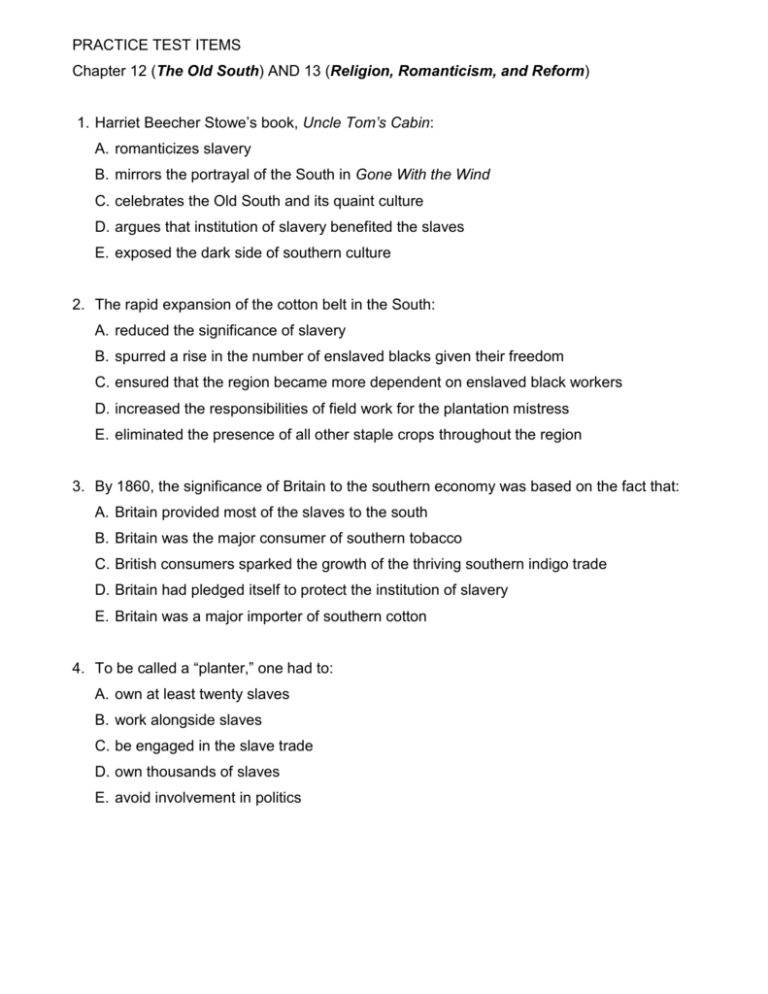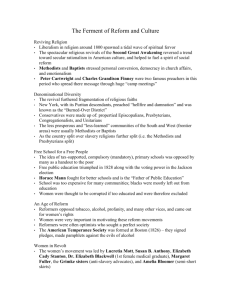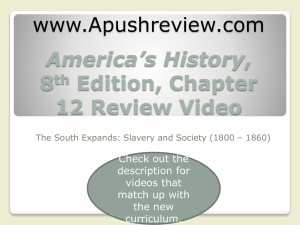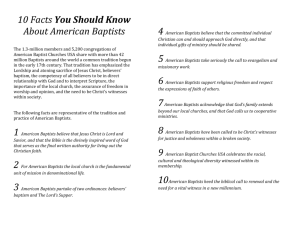PRACTICE TEST ITEMS Chapter 12 (The Old South) AND 13
advertisement

PRACTICE TEST ITEMS Chapter 12 (The Old South) AND 13 (Religion, Romanticism, and Reform) 1. Harriet Beecher Stowe’s book, Uncle Tom’s Cabin: A. romanticizes slavery B. mirrors the portrayal of the South in Gone With the Wind C. celebrates the Old South and its quaint culture D. argues that institution of slavery benefited the slaves E. exposed the dark side of southern culture 2. The rapid expansion of the cotton belt in the South: A. reduced the significance of slavery B. spurred a rise in the number of enslaved blacks given their freedom C. ensured that the region became more dependent on enslaved black workers D. increased the responsibilities of field work for the plantation mistress E. eliminated the presence of all other staple crops throughout the region 3. By 1860, the significance of Britain to the southern economy was based on the fact that: A. Britain provided most of the slaves to the south B. Britain was the major consumer of southern tobacco C. British consumers sparked the growth of the thriving southern indigo trade D. Britain had pledged itself to protect the institution of slavery E. Britain was a major importer of southern cotton 4. To be called a “planter,” one had to: A. own at least twenty slaves B. work alongside slaves C. be engaged in the slave trade D. own thousands of slaves E. avoid involvement in politics 5. The plantation mistress: A. usually led a life of idle leisure B. often criticized the prevailing social order and racist climate C. generally confronted a double standard in terms of moral and sexual behavior D. was sometimes known as the slave driver E. represented the typical southern white woman 6. During the nineteenth century, major slave rebellions: A. occurred frequently B. were rare C. were sometimes joined by poor whites D. had about even odds of success E. happened most often in the Lower South 7. The slave revolt led by Nat Turner: A. resulted in his escape to Canada B. was one of hundreds in American history C. proved the influence of abolitionists in the South D. was betrayed before it even got started E. killed more than 50 whites before its suppression 8. The rise of Romanticism indicated: A. recognition of the limits of science and reason B. a belief that Americans were too religious C. a desire for art and literature that was uniquely American D. a longing for love and passion in daily life E. a growing belief that man should dominate nature 9. How did American literature develop during the half decade between 1850 and 1855? A. It stagnated with only a few notable authors producing major literary works. B. Due to the influence of the Second Great Awakening, American literature at this time only emphasized religious themes. C. It is the only period in American history that did not produce a single “great author.” D. This era witnessed an outpouring of extraordinary literature by an array of authors who became giants of American literature. E. Censorship following the Mexican War resulted in a limited number of literary subjects deemed permissible to write about. 10. Which of the following statements is true about the number of newspapers in the United States by 1850? A. The number of newspapers lagged significantly behind Britain. B. The United States had more newspapers than any other nation in the world. C. The United States had the least number of newspapers for any country in the industrialized world. D. The “Old South” was the driving force behind newspaper expansion, with North Carolina alone having four times as many newspapers as all of New England. E. The year 1850 saw the founding of the first independent American newspaper. 11. Prison reformers of the early 1800s saw a major objective of the penitentiary as: A. religious conversion B. rehabilitation C. corporal punishment D. providing prisoners an education E. patriotic indoctrination 12. Dorothea Lynde Dix directed her reform efforts at: A. insane asylums B. public education C. women’s rights D. slavery E. temperance 13. The cult of domesticity was the idea that: A. women deserved education B. professions should be open to women C. romantic love was the basis of successful marriage D. large families were beneficial E. a woman’s place is in the home 14. The Seneca Falls Convention: A. celebrated the cult of domesticity B. demanded equal rights for women C. showed the mass appeal of temperance D. reflected female dominance of the abolitionist movement E. brought immediate improvements in women’s lives 15. The debate over slavery: A. moved Methodists and Baptists to take an anti-slavery position B. moved Methodists and Baptists to take a pro-slavery position C. split Methodists and Baptists into northern and southern denominations D. was generally ignored by Methodists and Baptists until the Civil War E. caused many Methodists and Baptists to be less religious











